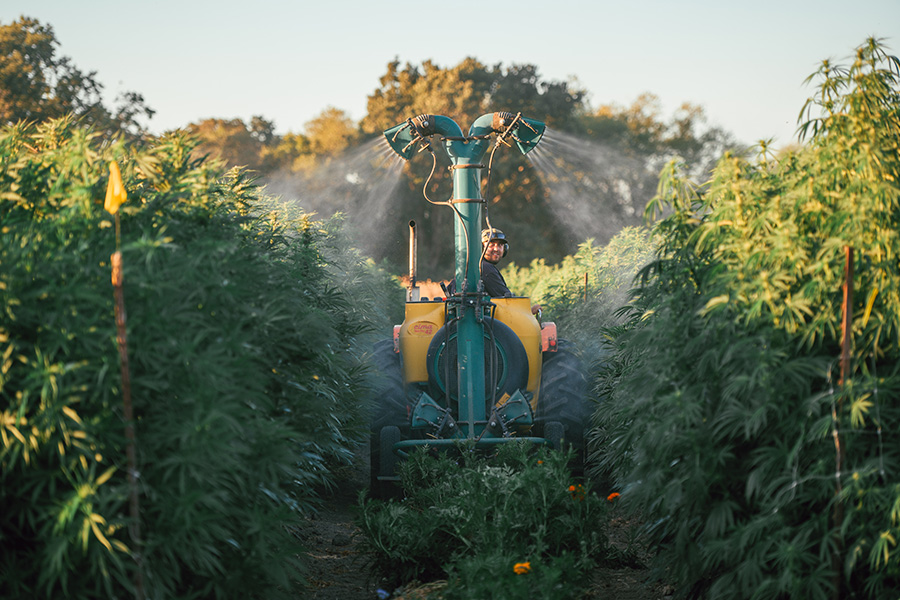When it comes to spraying crops after they have transitioned into the flowering stage, there are differing opinions among growers. While some adhere to the belief that no applications should be made once the plants enter flower, we adopt a modern approach that prioritizes human health and crop protection. In this blog post, we will provide some guidelines for spraying crops after they have entered the flowering stage. By following these recommendations, cannabis growers can navigate the complexities of product applications during this critical stage.
- Avoid Sulfur Applications after Week Two
To preserve the aroma and taste of the flowers, it is advisable to refrain from applying sulfur after the second week of flowering. Sulfur application can emit a strong sulfur smell, especially when the flowers are smoked. This smell can also affect the taste of extracted materials, prompting many extractors to recommend avoiding sulfur during the flowering phase. - Consider Weather Conditions
Avoid plant sprayers during or just before a heat spell. While we use a temperature threshold of eighty-five degrees Fahrenheit as a guide, it may need adjustment based on trial and error and the specific climatic conditions of your region. Applying sprays during high temperatures can increase the risk of plant stress and potential damage. - Choose the Right Time for Applications
Always make product applications when the plants are not in direct sunlight. Optimal timing is early morning or evening after the sun has set. Applying sprays in shaded conditions minimizes the risk of leaf burn and ensures better absorption and effectiveness of the products. - Follow Product Instructions
Carefully read and follow the instructions provided on the labels of the products you are using. Adhering to the recommended dosage and application methods is crucial for proper and safe utilization.
Complying with State Regulations
Each state has different regulations regarding the products allowed for application on cannabis crops. Familiarize yourself with these regulations to prevent accidental misapplication, which could render your flowers unsellable. Stay informed and updated on the approved products specific to your state.
Selecting the Right Products for Spraying During Flowering
As part of our spray program, we rely on Marrone Bio Innovations products, such as Grandevo, Regalia, and Venerate, for general prevention and maintenance. For caterpillar management during early flowering, we incorporate a BT product. Horticultural oils are effective against most pests, with Purespray Green™ being our current recommended choice. However, it is important to note that sulfur is specifically used for russet mites.
Proactive Disease and Mold Management
To effectively manage diseases, mold on plants, and mold on plant soil, it is crucial to be proactive. Once mold or powdery mildew has taken hold, complete eradication becomes challenging, and efforts become focused on containment. For botrytis and powdery mildew, we recommend products such as Double Nickel™, potassium bicarbonate, and sulfur. It’s important to be aware that extractors may prefer to limit sulfur use after transition or early flowering due to its potential impact on extraction flavor. Additionally, avoid using sulfur and horticultural oils within two weeks of each other to prevent plant damage.
Promoting Overall Agroecosystem Health in the Flowering Stage
To reduce or eliminate the need for excessive spraying, we encourage readers to refer to our insights on insects and fungi management. By adopting practices that promote overall agroecosystem health, it is possible to minimize the reliance on chemical interventions and move towards a more sustainable approach.
Timely and cautious application of sprays during the flowering stage is crucial for the health and quality of cannabis crops. Following the guidelines provided, such as avoiding sulfur applications after week two and considering weather conditions and proper timing, can help growers navigate the complexities of spraying during this critical growth phase. Familiarize yourself with state regulations and make informed choices about the products being used. Implement proactive disease and mold management strategies to prevent major outbreaks. By promoting overall agroecosystem health, cannabis growers can work towards reducing the need for excessive spraying and fostering sustainable cultivation practices.
